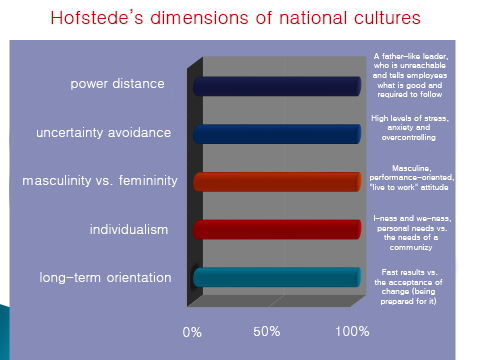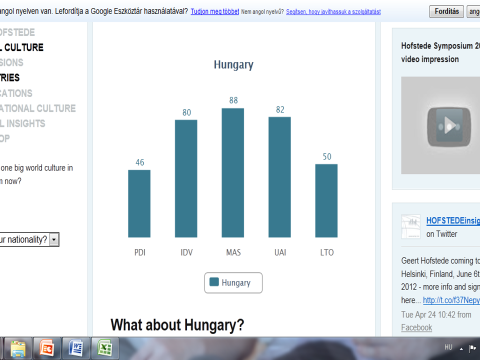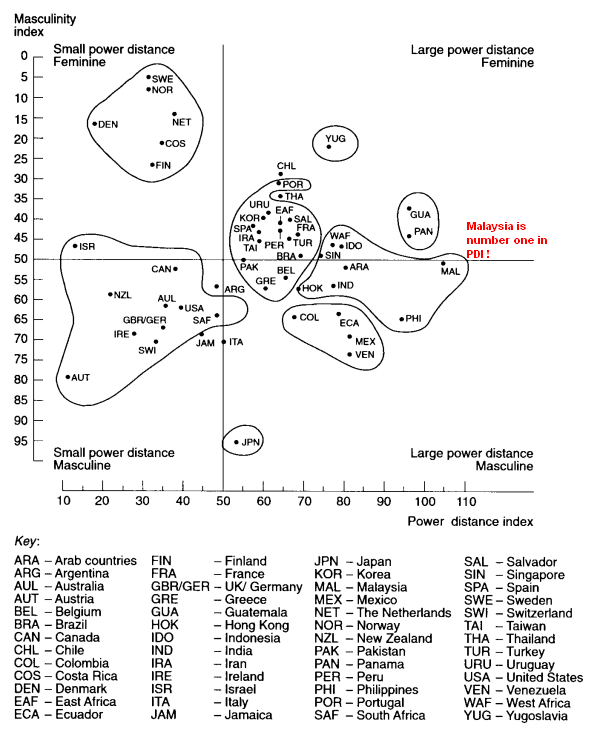Hofstede’s dimensions of national cultures
One may wonder whether a nation’s cultural characteristics are present in the cultures of the country’s (nation’s) organisations too. Hofstede, on the basis of the well-known IBM study[1], developed a new theoretical framework which makes it possible to describe and compare the characteristics of any national culture by means of 5 fundamental dimensions (see Fig. 8 and Fig. 9).
Hofstede established the following 5 dimensions (however, the original theory proposed only four in the beginning, and the fifth one, long-term orientation, was added later):
- Power distance: the degree of inequality that is accepted by those having power and those lacking the same. Low power distance means little inequality, while high power distance shows more serious inequality.
- Individualism vs. collectivism: certain national cultures prefer individuals working on their own, whereas other cultures find working as a member of a group much more important. Collectivistic societies value loyalty towards one’s groups and communities, and they also put special emphasis on helping one another. Individualistic societies, on the other hand, value individuals; the self is more important than the group, individuals “who can stand on their own feet” are preferred here.
- Masculinity vs. femininity: national cultures might also be characterised by means of the behaviour attributed to genders. The values that masculine cultures promote are performance, success, competitiveness, perseverance, whereas the values that characterise feminine cultures are sensitivity, solidarity, support, and human relationships. In masculine cultures, the differences between gender roles are more dramatic and distinct than in feminine ones.
- Uncertainty avoidance: this dimension shows how much certain societies need situations that are structured and controlled by rules. The latter might be either written or unwritten. Cultures with high uncertainty avoidance find it hard to cope with anxiety and are afraid of new situations, while cultures with low degrees of uncertainty avoidance are more flexible and happy with changes.
- Long-term orientation vs. short-term orientation: the way of thinking typical of cultures related to time.

Figure 8: Hofstede’s five-dimensional model of culture

Figure 9: The scores Hungary received in Hofstede’s framework
According to Hofstede, power distance and uncertainty avoidance are those dimensions that mainly determine what type of organisational structures are preferred in a country. As a matter of fact, the way people think of organisations mainly depends on what kind of employer-employee relationship they find acceptable, and how their environment tolerates uncertainty. On the basis of these characteristics, Hofstede differentiated between 4 types of organisations (see Fig. 10):
- Village market: low power distance and weak uncertainty avoidance characterise this type; Anglo-Saxon and Scandinavian countries belong to this category
- Well-oiled machine: low power distance and strong uncertainty avoidance characterise this type; mainly German-speaking countries belong to this category
- Family: high power distance and weak uncertainty avoidance characterise this type; South-eastern Asian countries belong to this category
- Pyramid: high power distance and strong uncertainty avoidance characterise this type; Latin cultures, some of the Far Eastern countries, and Islamic countries belong to this category
The following free prezi.com presentation summarises Hofstede’s work under the link below.
http://prezi.com/k8i3tuy1ddyw/new-hofstede/

Figure 10: A map of the world for each cultural dimension on the basis of Hofstede’s work
Source: http://www.nkkhoo.com/2012/04/13/repost-marina-mahathirs-article-censored-by-the-star-malaysia-is-number-one-in-the-power-distance-index/
Organisational culture significantly affects how well organisations work; it is responsible for their success or failure. When establishing a sports organisation, or taking the leadership of one that has been working for a while, we should bear in mind that the strengthening of its organisational culture is of primary importance, if required also by means of rules (such as a code of conduct). These solutions help individuals act according to what is accepted, improves the club and its identity, differentiates the club from others, and promotes the achievement of mutually set goals through shared values and norms.
[1] For further details it is recommended to visit the homepage of Geert Hofstede: http://geert-hofstede.com/